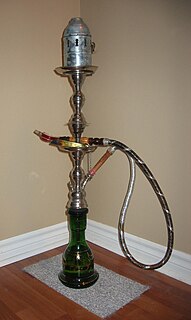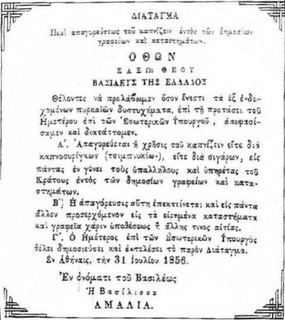
The Freedom to Breathe Act of 2007 is a piece of Minnesota legislation that restricts the act of smoking tobacco products in public places. It amends sections of Minnesota Clean Indoor Air Act (MCIAA) of 1975.

The Freedom to Breathe Act of 2007 is a piece of Minnesota legislation that restricts the act of smoking tobacco products in public places. It amends sections of Minnesota Clean Indoor Air Act (MCIAA) of 1975.
On May 16, 2007, the U.S. state of Minnesota passed the Freedom to Breathe Act. This act protects the public from hazardous secondhand smoke by banning smoking in public places. The ban took effect October 1, 2007. Minnesota is the 17th state to enforce a statewide smoking ban. [1] The original and major supporters of the 1975 regulations are very pleased to see the new doctrine pass through legislation and sign into law. [2] In an inForum online article, Don Davis quoted several House Republicans against the bill. Representative Bud Heidgerken (R-Freeport) says that the ban will hurt small enterprises and presented a kink in the State's plan. He stated, "You are going to vote them out of business tonight." Likewise, Dennis Ozment (R-Rosemount) stated that the passage of the bill is "tyranny, oppressive governmental power... This piece of legislation turned out to be just plain mean". [3]
The 2007 anti-smoking act was not the first in the state to pass into law. The Minnesota Clean Indoor Air Act (MCIAA) took in effect 1975. [4] The purpose of this act was to enforce the "protection of the public health." It prohibited smoking in areas where children, ill or injured are present. This first Minnesota act also limited smoking indoor at public places and private meetings.
Smoking is permitted in the following places: [5]
An indoor area is defined as the space between a floor and a ceiling that is bounded by walls covering more than 50 percent of the perimeter of the area. Temporary physical barriers are considered walls, but certain window screens are not. [6]
| Wikinews has related news: |

Smoking bans, or smoke-free laws, are public policies, including criminal laws and occupational safety and health regulations, that prohibit tobacco smoking in certain areas, usually in enclosed workplaces and other public spaces. Such policies are usually enacted to protect people from the negative health effects of passive smoking or second-hand smoke (SHS) exposure.
The loi Évin is the French alcohol and tobacco policy law passed in 1991. It takes its name from Claude Évin, then Minister of Health, who proposed it to Parliament.
The Smoke Free Illinois Act is a comprehensive anti-smoking law that took effect in Illinois on January 1, 2008, and bans smoking inside most buildings and vehicles used by the general public, used as a place of employment, or owned by the government or other public body. It also requires "no-smoking" signs, bans smoking within 15 feet (4.6 m) of openings in the targeted buildings, and requires at least 75% of rooms in each hotel to be non-smoking. It replaced the more limited Illinois Clean Indoor Air Act.
The Tobacco Products Control Act was introduced in South Africa in 1993, where smoking has been rated the second highest health concern, after HIV/AIDS.

Tobacco politics refers to the politics surrounding the use and distribution of tobacco.

Smoking in Taiwan is regulated by the Tobacco Hazards Prevention Act (Taiwan). Tobacco advertising is banned, and smoking is banned in all indoor public places. Taiwan was the second Asian country to institute an indoor smoking ban, after Bhutan. The Government of Taiwan is planning to extend the smoking ban to cars, motorbikes, and pedestrians.

Regulation of tobacco by the U.S. Food and Drug Administration began in 2009 with the passage of the Family Smoking Prevention and Tobacco Control Act by the United States Congress. With this statute, the Food and Drug Administration (FDA) was given the ability to regulate tobacco products.
Minnesota Medical Association (MMA) is a non-profit professional association representing physicians, residents, and medical students, working together for a healthy Minnesota. With 10,000 members, the MMA is an advocate on health care issues at the State Capitol and in Washington D.C. It provides a connection between physicians and lawmakers through a variety of events at the State Capitol and in legislator's home districts.

The use of tobacco products in Egypt is widespread. It is estimated that approximately twenty percent of the population uses tobacco products daily. Cigarettes are the most common form of tobacco consumption in Egypt, with an estimated twenty billion cigarettes smoked annually in the country. After cigarettes, shisha water-pipes are the most common form of tobacco consumption. Many Egyptians are not fully aware of the health risks of using a water-pipe and many believe it to be less harmful than cigarettes.

SmokinginCanada is banned in indoor public spaces, public transit facilities and workplaces, by all territories and provinces, and by the federal government. As of 2010, legislation banning smoking within each of these jurisdictions is mostly consistent, despite the separate development of legislation by each jurisdiction. Notable variations between the jurisdictions include: whether, and in what circumstances ventilated smoking rooms are permitted; whether, and up to what distance away from a building is smoking banned outside of a building; and, whether smoking is banned in private vehicles occupied by children.
Smoking in Ireland is banned fully in the general workplace, enclosed public places, restaurants, bars, education facilities, healthcare facilities and public transport. However, it is permitted in designated hotel rooms and there is no ban in residential care, prisons and in outdoor areas. Public opinion is in favour of the bans on smoking imposed in Ireland.

Smoking in Greece was at the highest rate of tobacco consumption in the European Union in 2010. In 2014, Greece had the highest rate of smoking in the European Union. According to a survey published by the European Commission Day for World No Tobacco Day in 2017, 37% of Greeks are smokers and only 44% of Greeks have never smoked a cigarette, the smallest percentage in the EU. After Greece, France and Bulgaria have the next largest number of smokers with 36%. At 7%, Sweden had the lowest rate.
Smoking in India has been known since at least 2000 BC when cannabis was smoked and is first mentioned in the Atharvaveda. Fumigation (dhupa) and fire offerings (homa) are prescribed in the Ayurveda for medical purposes and have been practiced for at least 3,000 years while smoking, dhumrapana (धूम्रपान), has been practiced for at least 2,000 years. Tobacco was introduced to India in the 17th century. It later merged with existing practices of smoking.
Regulation of electronic cigarettes varies across countries and states, ranging from no regulation to banning them entirely. For instance, e-cigarettes were illegal in Japan, which forced the market to use heat-not-burn tobacco products for cigarette alternatives. Others have introduced strict restrictions and some have licensed devices as medicines such as in the UK. However, as of February 2018, there is no e-cigarette device that has been given a medical license that is commercially sold or available by prescription in the UK. As of 2015, around two thirds of major nations have regulated e-cigarettes in some way. Because of the potential relationship with tobacco laws and medical drug policies, e-cigarette legislation is being debated in many countries. The companies that make e-cigarettes have been pushing for laws that support their interests. In 2016 the US Department of Transportation banned the use of e-cigarettes on commercial flights. This regulation applies to all flights to and from the US. In 2018, the Royal College of Physicians asked that a balance is found in regulations over e-cigarettes that ensure product safety while encouraging smokers to use them instead of tobacco, as well as keep an eye on any effects contrary to the control agencies for tobacco. A recent study shows electronic device company "JUUL" contains carcinogens and other harmful ingredients inside their e-juice cartridges.
The Oregon Indoor Clean Air Act, also known as the Smokefree Workplace Law, is a measure passed in 1981 by the US State of Oregon prohibiting smoking in public indoor places except in certain designated smoking areas. The objective is to protect non-smokers in confined areas from second-hand smoke. Beginning on January 1, 2016, the law was extended to cover "inhalant delivery systems" such as e-cigarettes.

Executive Order No. 26, entitled Providing for the Establishment of Smoke-Free Environments in Public and Enclosed Places, was issued by Philippine President Rodrigo Duterte on May 16, 2017. This executive order invoked the Clean Air Act of 1999 and the Tobacco Regulation Act of 2003 to impose a nationwide ban on smoking in all public places in the Philippines. The ban replicates on a national level an existing ordinance in Davao City that Duterte created as mayor in 2002. The order took effect on July 23, 2017, 60 days after its publication in a newspaper.